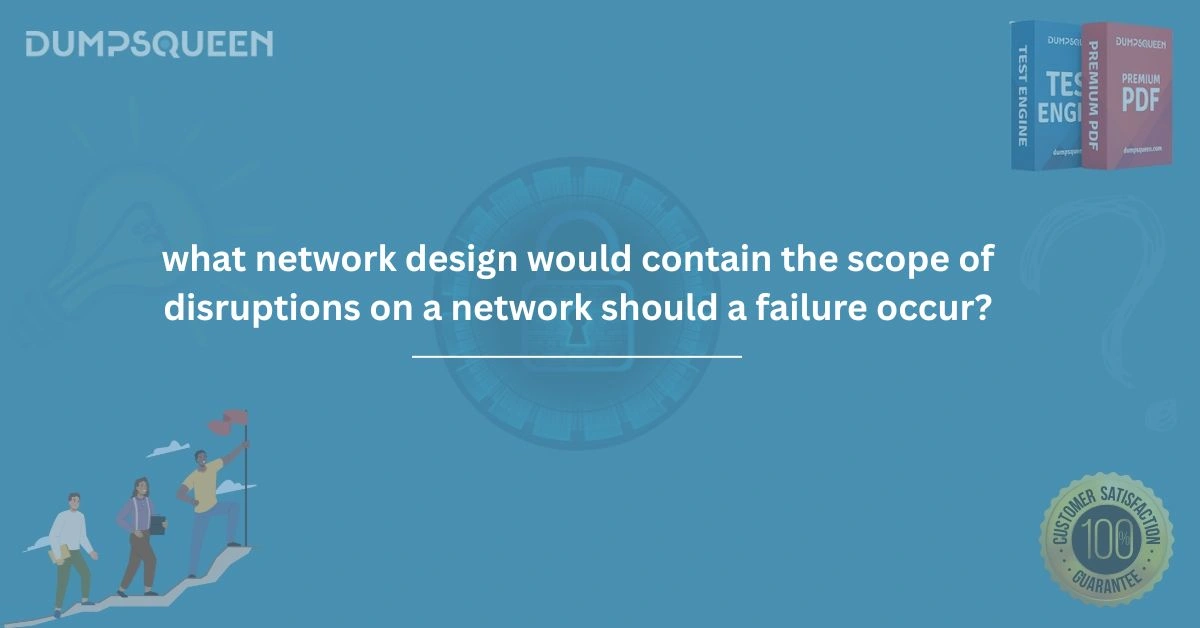Introduction
In today's digitally connected world, businesses and organizations rely heavily on robust and uninterrupted network services. Whether it's cloud computing, data transmission, voice over IP (VoIP), or video conferencing, the demand for a resilient network infrastructure is higher than ever. Network failures, even if momentary, can lead to significant productivity loss, revenue impact, and damage to an organization’s reputation. It is in this context that the question arises: what network design would contain the scope of disruptions on a network should a failure occur? This is not just a theoretical concern it’s a fundamental aspect of real-world network architecture planning. For IT professionals and certification aspirants, especially those preparing for exams offered at DumpsQueen, understanding this concept is crucial. The ability to design networks that can withstand failures and minimize disruptions is a critical skill. This article explores in depth the network design approach that can localize and minimize the impact of failures, and why this design is preferred in both enterprise and service provider environments.
Understanding Network Failures and Their Impact
Before diving into the design strategies, it's essential to understand the nature of network failures. Failures can occur due to various reasons hardware malfunction, software bugs, misconfigurations, power outages, or even cyberattacks. When a failure happens in a poorly designed network, it can lead to widespread outages. In contrast, a well-designed network will localize the failure and allow other parts of the network to continue functioning unaffected. So, what network design would contain the scope of disruptions on a network should a failure occur? The answer lies in the concept of modular network design, particularly designs that use hierarchical models and segmentation.
Hierarchical Network Design: The First Line of Defense
One of the most effective ways to contain disruptions is through hierarchical network design. This model breaks the network into distinct layers typically core, distribution, and access layers. Each layer has a defined role, and the traffic between them is carefully controlled. In such a design, if a failure occurs at the access layer (such as a switch failure), it only affects the devices directly connected to that switch. The rest of the network remains unaffected. This containment of impact is a fundamental advantage of the hierarchical approach. The hierarchical model also enables simpler troubleshooting, easier network scaling, and logical segmentation of functions and users. These characteristics help to isolate issues quickly and minimize their spread across the infrastructure.
Redundancy and Failover: Minimizing Downtime
Another critical component of network design that contains the scope of disruptions is redundancy. Redundancy involves adding backup links, devices, and power sources so that if one component fails, another can take over without affecting the network’s operation. For example, having dual core switches, redundant power supplies, and multiple uplinks from access switches ensures that traffic can be rerouted if any path fails. This concept is closely tied to high availability (HA) and is central to enterprise-grade networking. Failover mechanisms are automated in most cases, which means traffic can reroute dynamically without human intervention. This ensures that critical services remain available even during partial network outages.
Network Segmentation: Limiting the Blast Radius
Network segmentation refers to dividing the network into smaller, manageable sections, often using VLANs, subnets, or even physical separation. This approach limits the "blast radius" of any failure. If a broadcast storm or malware outbreak occurs in one segment, it cannot easily propagate to other parts of the network. In this way, segmentation effectively contains disruptions and ensures that critical services hosted on separate segments remain operational. This design is commonly applied in data centers, campuses, and even cloud architectures. It is also a recommended best practice in network security frameworks like Zero Trust, which emphasize isolation and controlled communication between segments.
Spanning Tree Protocol and Loop Avoidance
At the Layer 2 level, the Spanning Tree Protocol (STP) plays a significant role in containing network disruptions caused by switching loops. STP prevents the formation of loops by identifying and blocking redundant paths in the topology. In failure scenarios, it quickly reconfigures the path to ensure traffic continues to flow. Advanced versions like Rapid Spanning Tree Protocol (RSTP) and Multiple Spanning Tree Protocol (MSTP) offer faster convergence times and scalability. These protocols are integral to ensuring that failure in one segment of the network does not bring the entire network down.
Routing Protocols and Convergence
Routing protocols are critical in determining what network design would contain the scope of disruptions on a network should a failure occur. Protocols such as OSPF (Open Shortest Path First) and EIGRP (Enhanced Interior Gateway Routing Protocol) are designed to detect changes in the network topology and converge quickly to a new optimal path. Fast convergence ensures minimal packet loss and service disruption. Additionally, route summarization and area-based configuration in OSPF help localize the impact of routing changes, preventing a single failure from flooding the entire routing domain with updates.
Cloud and Hybrid Networks: Built-in Resilience
Modern enterprise networks are not confined to a single on-premises location. With the rise of cloud computing and hybrid environments, designing for resilience becomes more complex but also more critical. Cloud providers like AWS, Azure, and Google Cloud offer region and availability zone-based architectures to ensure that failures in one location do not affect the global availability of services. These designs naturally align with the principle of containing disruptions through isolation and redundancy. Enterprises leveraging hybrid architectures must ensure that their connections to cloud resources are redundant, encrypted, and monitored, further reinforcing the concept of a network design resilient to failures.
Real-World Use Case: Enterprise Campus Network
Let’s consider a real-world example of an enterprise campus network. Such a network is typically segmented by department (HR, Sales, IT), each with its own VLAN and access policies. The core of the network houses redundant routers and firewalls, with distribution switches feeding into separate access switches for each building. If a power surge disables a switch in the Sales building, only that building’s users are affected. The HR and IT departments continue functioning normally. Why? Because the network design contains the disruption by isolating the failure to a specific segment of the infrastructure. This is the practical answer to what network design would contain the scope of disruptions on a network should a failure occur? a hierarchical, segmented, and redundant network.
Certification Relevance and DumpsQueen Advantage
For certification aspirants, understanding the design strategies discussed above is crucial. Questions around fault tolerance, failure containment, and high availability frequently appear in exams such as:
-
Cisco 200-301 (CCNA)
-
CompTIA Network+ (N10-008)
-
Cisco ENCOR 350-401
At DumpsQueen, you can access verified exam dumps, practice questions, and expert study guides tailored for these certifications. With DumpsQueen, you not only learn the theory behind network designs but also practice real exam questions that reinforce your understanding.Whether you're preparing for a certification or working in a professional network engineering role, DumpsQueen ensures you're equipped with both the knowledge and the tools to succeed.
Free Sample Questions
Question 1: What network design approach helps contain disruptions to a specific part of the network during a failure?
A. Flat network
B. Hub-and-spoke
C. Hierarchical design
D. Peer-to-peer network
Answer: C. Hierarchical design
Question 2: Which protocol is responsible for avoiding Layer 2 loops in Ethernet networks?
A. OSPF
B. RIP
C. STP
D. DHCP
Answer: C. STP
Question 3: What is a major benefit of using VLANs in network design?
A. Increase broadcast domain size
B. Reduce switch speed
C. Contain broadcast traffic and faults
D. Prevent routing between devices
Answer: C. Contain broadcast traffic and faults
Question 4: In the context of network failure, what is meant by the term “blast radius”?
A. The total bandwidth of a router
B. The area of failure impact
C. The number of routers in a path
D. The total power consumption
Answer: B. The area of failure impact
Conclusion
When planning and implementing a network, resilience and fault containment should always be at the forefront of the design process. The ability to limit the scope of disruption during a failure isn’t just a nice-to-have it’s a necessity in modern, mission-critical environments. So, what network design would contain the scope of disruptions on a network should a failure occur? The clear answer is a modular, hierarchical, segmented, and redundant design. This architecture ensures that network services continue to function, even when individual components fail, and provides a strong foundation for scalability, performance, and security. At DumpsQueen, we're committed to helping professionals master these concepts through top-quality learning resources and practice materials. If you're preparing for a networking exam or seeking to enhance your technical skills, DumpsQueen is your go-to destination.Start learning smart. Start learning with DumpsQueen.




